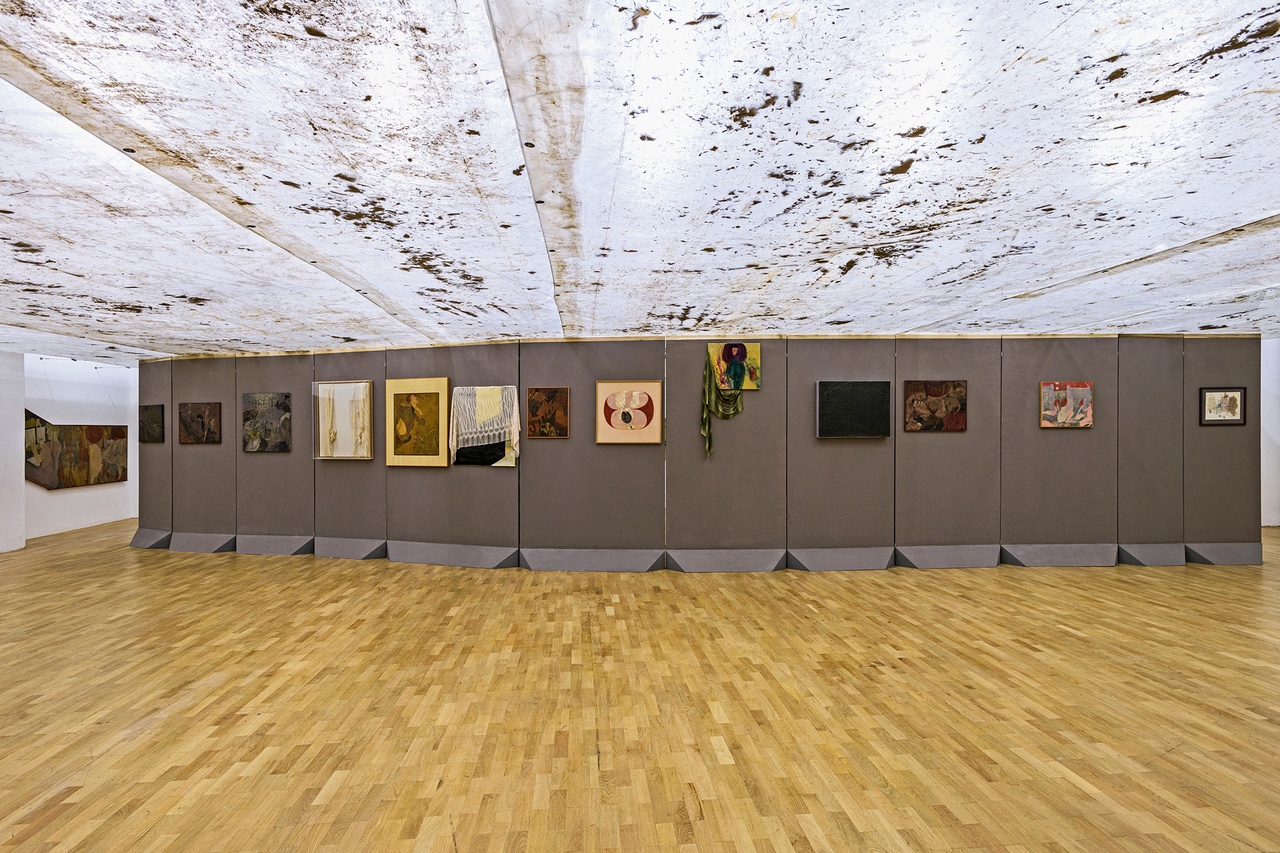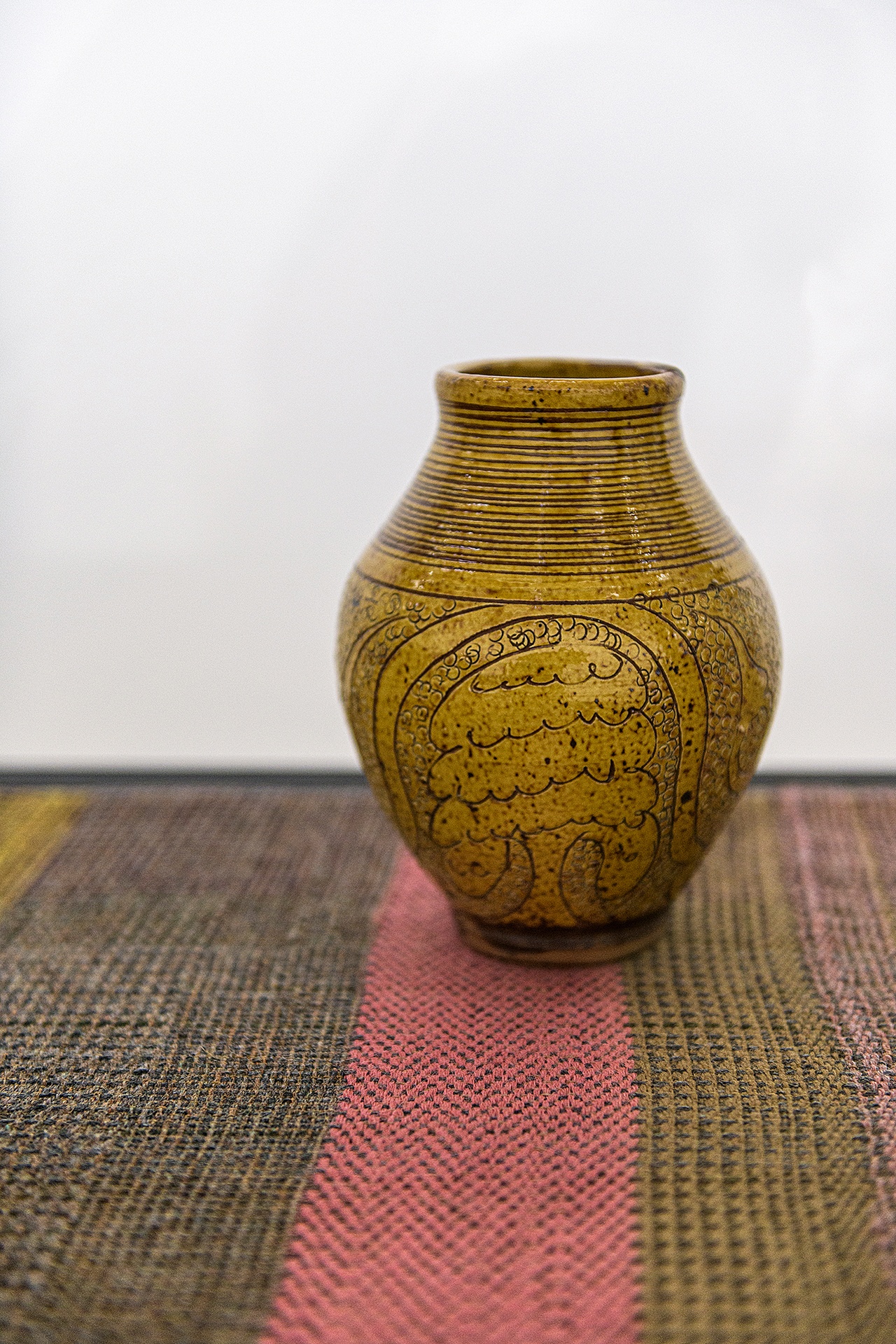CHILD’S PLAY Talia Kwartler on “Kai Althoff goes with Bernard Leach” at Whitechapel Gallery, London

“Kai Althoff goes with Bernard Leach,” Whitechapel Gallery, London, 2021, installation view
“As Kai Althoff says, he wishes his painting to function ideally like one of Bernard Leach’s pots,” Francia Gimbel-Masters writes in the exhibition guide for “Kai Althoff goes with Bernard Leach” at Whitechapel Gallery. [1] “Gimbel-Masters” is but one of Althoff’s artistic personas. Disguised in this way, Althoff suggests the multifaceted self-presentation at work in the exhibition itself. Drawing upon the renowned British studio potter Leach (1887–1979) as a mirror of himself, Althoff reveals far more than he usually does about the countless façades behind which he so often hides.
To organize any exhibition, let alone one of this scale with an artist of this slippery kind, during a pandemic is a formidable task. In this regard, the curators, Iwona Blazwick, Emily Butler, and Cameron Foote, are to be commended for bringing to life a complex body of work in such a rich manner. For Althoff’s first institutional show in the United Kingdom, the curators took up Althoff’s proposal to make an exhibition alongside Leach’s ceramics. An accompanying catalogue, taking a form closer to an artist’s book and featuring installation views, materials from Althoff’s personal archive, and essays by Blazwick, Dominic Eichler, and Matthew Tyas, will be published in spring 2021.
Upon entering the show, the visitor finds a large gallery divided by a gray wooden partition lined with fabric and then painted. The ceiling is covered with a canopy made of translucent polythene sheeting that makes the entire room feel compressed, almost womb-like. Althoff treated the canopy like a living object, leaving it to weather during the spring lockdown in a forest in Broxbourne in Hertfordshire, northeast of London. The leaves, twigs, fungus, soil, tire tracks, and footprints that the sheeting accumulated during its sojourn in the woods were left intact when it was hung at Whitechapel Gallery. Althoff specified that none of the walls were to be repainted during the installation, a directive that led to numerous pencil marks remaining visible on the walls, corresponding to where the installation team measured the position for the canopy and the placement of the paintings.
Althoff is a sensorial artist who mixes media and materials at will to suit his different guises. This shapeshifting is particularly clear in the artworks on display in the first gallery, a dense hang of paintings, drawings, and collages spanning three decades of Althoff’s career. The art-historical evocations here are manifold, from Toulouse-Lautrec and japonisme to Piero Manzoni and hieroglyphics. In this canopied gallery, the visitor enters into a space that appears at first bright and dappled like a forest, only to leave feeling physically oppressed by the sheer number of works and magnitude of images on display.
Upstairs from the first gallery, with its retrospective-like feel, a small gallery serves as an antechamber to the large, sparsely installed space devoted to Leach. This gallery features another tightly hung arrangement of Althoff’s work, including a generous group of drawings huddled closely together on a table. Many of the paintings are draped with fabric as if in viewing the painting you are looking through a curtain onto a stage. The materials echo both the canopy from the gallery below as well as Untitled (2005), a work shrouded with something akin to a tallit, a Jewish prayer shawl, which hangs on the wooden room divider. Cohabitating with Althoff’s work is one of Leach’s ink drawings, Sleep in the Hills (My Son David) (1918), installed at the far end of the small gallery. The drawing emphasizes that this space is a prelude to Althoff’s selection of Leach’s pottery, the true centerpiece of the show.
The last gallery holds an exquisite and aesthetically innovative installation of Leach’s ceramics, from plates and pots to necklaces and painted tiles. They are presented in a group of connected display cases designed by Althoff and rest on a woven textile pattern created in California by the weaver Travis Meinolf. He made the fabric on a traditional loom from wool, alpaca, silk, and other mixed materials. Meinolf’s intricate patterned textiles heighten the designs on Leach’s ceramics. In many of his ceramics, Leach incised ornamental elements into the surface of the clay or glaze. These include a tile painted with a blue tulip and an ashtray decorated with branches of colored fruit.

“Kai Althoff goes with Bernard Leach,” Whitechapel Gallery, London, 2021, installation view
If we are to take Gimbel-Masters at “her” word, that Althoff “wishes his paintings to function ideally like one of Bernard Leach’s pots,” then we realize that the artist is once again slithering away, using Leach as another one of his chameleon-like disguises. Even though the exhibition does not directly elaborate on Althoff’s fascination with Leach, the artist shows more of his hand through his exhibition design. While the two large galleries are installed in very different manners, they are divided in a strikingly similar way. Whether through a curving wooden yet stone-like partition or a steel and wood display case arranged at an extremely slight diagonal angle, Althoff uses installation to play with the visitor’s perception of Leach and of himself.
The key to understanding Althoff’s mystery lies within his continued emphasis on childhood. In the gallery devoted to Leach, Althoff includes two of his own works: a drawing he made with a felt-tip pen circa 1969, when he would have been around three or four, and an untitled sculpture that presides over the room like a religious figure. This sculpture is a two-part subject, with a female figure dangling a smaller creature upside down from her outstretched hand, like a fallen angel or a haunted Madonna and Child. While this grotesque pair is in many ways revolting, the materials that Althoff used to construct his subjects are tactilely absorbing, from the lush velvet used for the child’s body to the child-like drawings in India ink that ornament the mother figure’s face and hair.
Of course, dolls and figurines also appeared frequently in Althoff’s 2016 MoMA exhibition, entitled “and then leave me to the common swifts.” However, that densely packed gallery, populated with everything from dressmaker mannequins and paintings in crates to studio detritus, was remarkably different from Althoff’s presentation at Whitechapel Gallery. On the occasion of his MoMA show, Althoff said, “Other people are telling me I am an artist, but I think I am doing things the same way I did them when I was a child.” [2] At Whitechapel Gallery, Althoff taunts people who might think a Pollock or a Rothko could be made by a child by literally placing one of his own abstract drawings from childhood within the exhibition.
If we interpret Althoff as making artwork in “the same way [he] did” as a child, we are led to understand the artist as a person absorbed in his own childhood fantasies. Juxtaposing his work with Leach’s ceramics, Althoff points to his “deeply rooted love for the work of this man” [3] as being a kind of “mother” for his own art. However, Althoff’s presentation of Leach’s art as a quasi-mother reveals that this maternal origin is not a particularly caring one, but rather, one that hangs Althoff from her hand, ready to cast him into the deep end of artistic creation.
Many critics have railed against Althoff’s problematic appropriations of other cultures. I would argue that to take Althoff’s Orientalist games at face value would be to let this trickster artist off too easy. He means to challenge the viewer with his depictions of everything from gashing wounded legs to officers drinking beer to Hasidic Jews. In the catalogue for the MoMA show, Althoff concludes, “I do not want to be remembered.” [4] His artistic provocations emphasize the falsity of this claim. “Kai Althoff goes with Bernard Leach” is but another example of Althoff’s mastery at constructing installations that are dark and twisted, yet absolutely captivating. He is completely consumed by other genders, cultures, and religions, and the power of the Whitechapel show is putting these obsessions on display.
“Kai Althoff goes with Bernard Leach,” Whitechapel Gallery, London, October 7, 2020–January 10, 2021.
Notes
| [1] | See Francia Gimbel-Masters, “Kai Althoff Goes with Bernard Leach,” exhibition guide, Whitechapel Gallery, October, 2020. |
| [2] | “Kai Althoff in conversation with Laura Hoptman,” Kai Althoff: and then leave me to the common swifts (und dann überlasst mich den Mauerseglern), exh. cat., ed. Kai Althoff (New York: Museum of Modern Art, 2016), p. 44. |
| [3] | Gimbel-Masters (2020). |
| [4] | “Kai Althoff in conversation with Laura Hoptman,” p. 145. |
